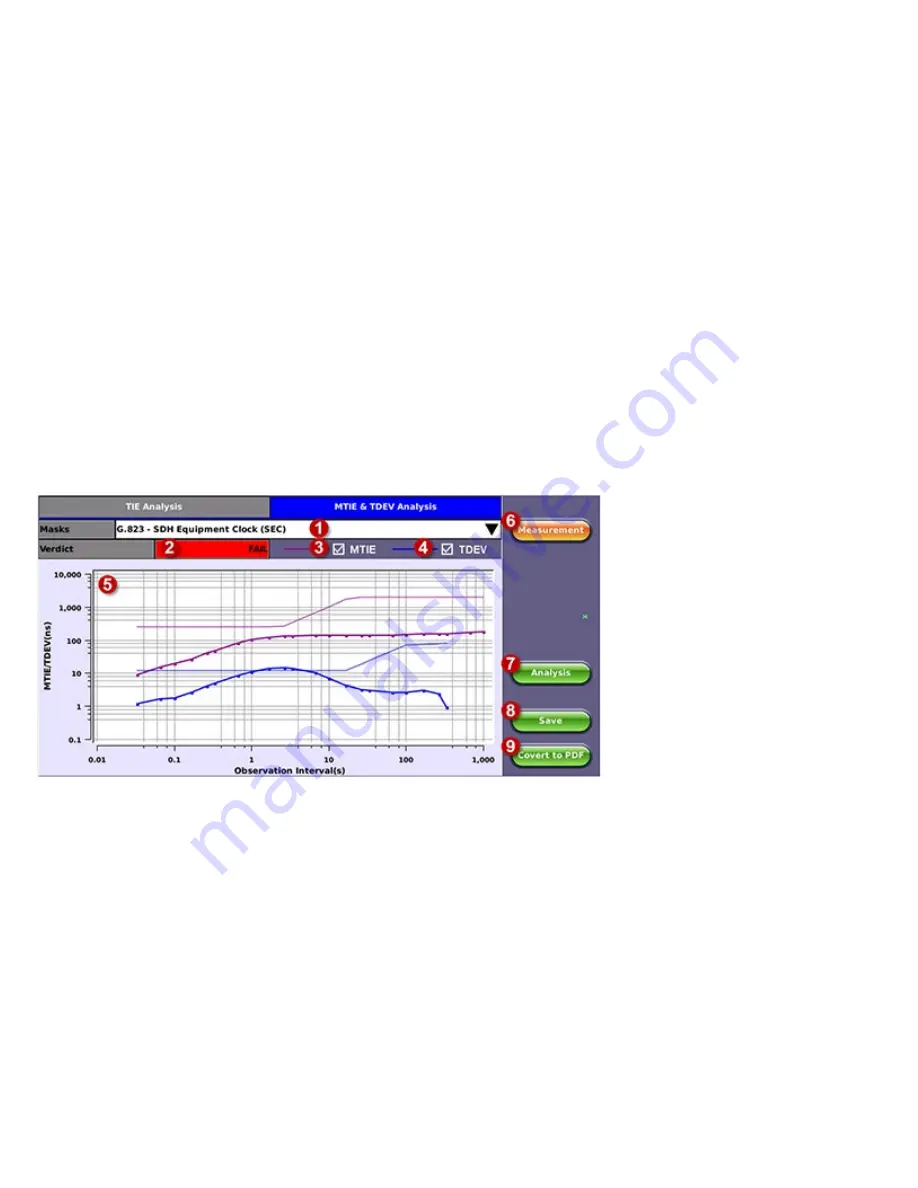
1. Date and Time stamp indicating when the test was started
2. Total of seconds recorded during the test
3. Beginning and end of the data set to be analyzed and displayed in the graph (5) below. Tap in the Start and/or
End field and enter the desired time limits, then press the Set Range button to apply these changes.
4. Based on all the TIE measurements captured, the test set automatically calculates any small difference in
frequency between the signal under test and the reference clock. Once the frequency difference is known, users
can remove it to perform Relative TIE measurements. The offset removal tool is important for field tests when
the local reference clock used is highly accurate and stable but not traceable to the PRC in the network core (e.g.
a portable frequency reference). Even if the frequency of the local reference is a few ppb (parts per billion)
different than the PRC, it can still be used for wander measurements, as long as it is highly stable, because the
Offset Removal feature can mathematically remove the know difference and make it as if a traceable reference
had been used. Once removed, user can perform relative MTIE (or MRTIE) and TDEV analysis.
5. Auto-scale TIE graph, based on the limits set.
6. Press the Measurement button to return to the current wander measurements
7. Fine cursor controls. User can use the stylus to tap on the screen to position the cursor and then use these arrow
buttons to position the cursor and read specific TIE values. The rubber cursor keys can also be used to move the
cursor.
MTIE & TDEV Pass/Fail Analysis
MTIE Results
1. Standard MTIE & TDEV masks selection
2. Pass or Fail indicator, evaluated depending on selected masks
3. MTIE line color indicator and Enable/Disable check box
4. TDEV line color indicator and Enable/Disable check box
5. MTIE & TDEV logarithmic graphs and standard masks
6. Press this button to return to the wander measurements screen
7. Once the mask has been selected, press Analysis to run the MTIE and/or TDEV calculations. Depending on the
number of samples collected, this calculation could take a few minutes.
8. Save the MTIE, TDEV and mask calculations in CSV format to a USB Memory stick. The graph can be
recreated using a spreadsheet program like Microsoft® Excel, printed as a report or shared via email or any
other electronic media
9. Generates a MTIE and TDEV report in PDF format to a USB Memory stick.
RXT-6200_RXT6000e_Module_Manual
Page 186 of 387
Содержание RXT-6000e
Страница 1: ......
Страница 39: ...Rx Pattern Setup Go back to top Go back to TOC RXT 6200_RXT6000e_Module_Manual Page 39 of 387...
Страница 48: ...Tx Interface Setup Tx Structure Setup Text Mode RXT 6200_RXT6000e_Module_Manual Page 48 of 387...
Страница 61: ...RXT 6200_RXT6000e_Module_Manual Page 61 of 387...
Страница 97: ...RXT 6200_RXT6000e_Module_Manual Page 97 of 387...
Страница 199: ...RXT 6200_RXT6000e_Module_Manual Page 199 of 387...
Страница 200: ...Go back to top Go back to TOC Errors Alarms Page 2 RXT 6200_RXT6000e_Module_Manual Page 200 of 387...
Страница 232: ...BERT Results Signal Go back to top Go back to TOC RXT 6200_RXT6000e_Module_Manual Page 232 of 387...
Страница 254: ...Background Results Per Stream Go back to top Go back to TOC RXT 6200_RXT6000e_Module_Manual Page 254 of 387...
Страница 267: ...Event Log Go back to top Go back to TOC RXT 6200_RXT6000e_Module_Manual Page 267 of 387...
Страница 327: ...Go back to top Go back to TOC RXT 6200_RXT6000e_Module_Manual Page 327 of 387...
Страница 351: ...Go back to top Go back to TOC RXT 6200_RXT6000e_Module_Manual Page 351 of 387...






























